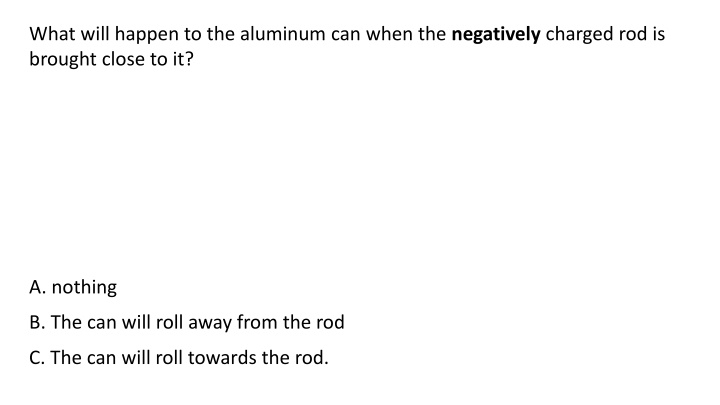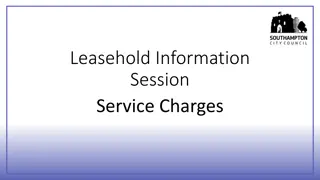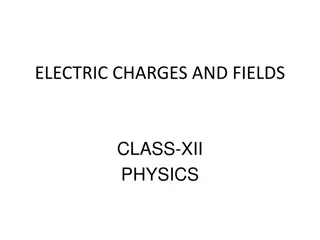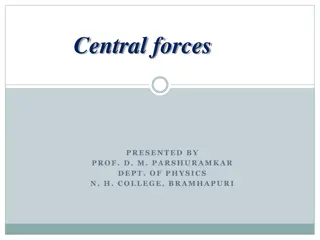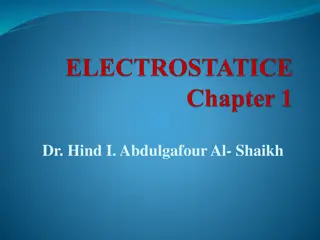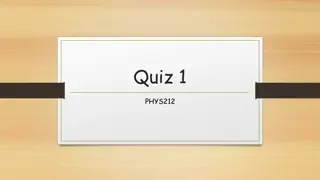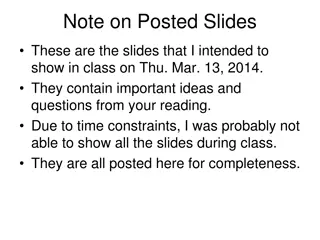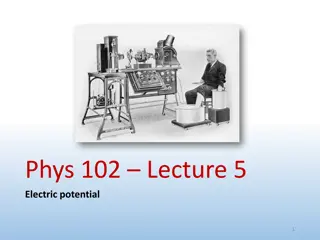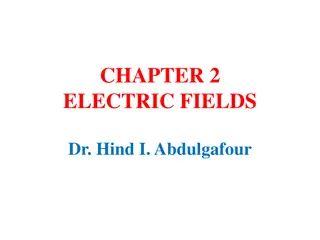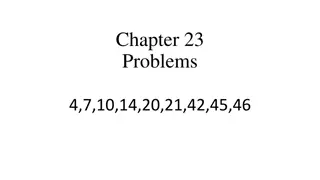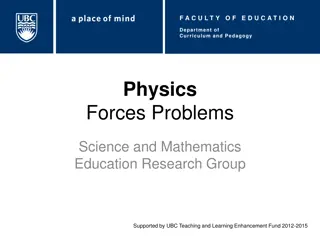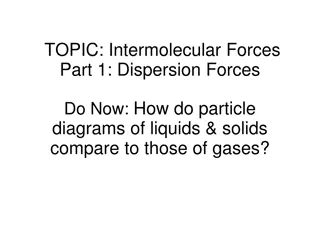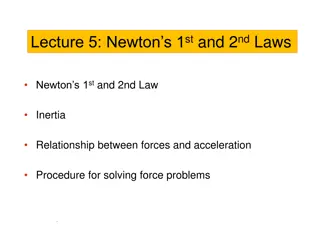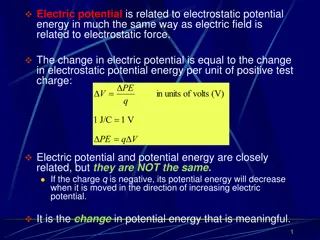Physics Study Questions on Electric Charges and Forces
Delve into a series of multiple-choice physics questions related to electric charges and forces. Explore scenarios involving charged rods and objects, electrostatic forces between spheres, interactions between charged socks, experiments to determine charge, and conclusions drawn about the magnitudes of charges based on observations.
Download Presentation

Please find below an Image/Link to download the presentation.
The content on the website is provided AS IS for your information and personal use only. It may not be sold, licensed, or shared on other websites without obtaining consent from the author.If you encounter any issues during the download, it is possible that the publisher has removed the file from their server.
You are allowed to download the files provided on this website for personal or commercial use, subject to the condition that they are used lawfully. All files are the property of their respective owners.
The content on the website is provided AS IS for your information and personal use only. It may not be sold, licensed, or shared on other websites without obtaining consent from the author.
E N D
Presentation Transcript
What will happen to the aluminum can when the negatively charged rod is brought close to it? A. nothing B. The can will roll away from the rod C. The can will roll towards the rod.
What will happen to the aluminum can when the positively charged rod is brought close to it? A. nothing B. The can will roll away from the rod C. The can will roll towards the rod.
What will happen to the 2x4 when the negatively charged rod is brought close to it? A. nothing B. The 2x4 will be pushed away from the rod C. The 2x4 will be pulled toward the rod
Two uniformly charge spheres are attached to frictionless pucks on an air table. The charge on sphere 2 is three times the charge on sphere 1. Which force diagram correctly shows the magnitude and direction of the electrostatic forces on the two spheres? Pink A Green B Blue C Yellow D Purple E
Two socks are observed to attract each other. Which, if any, of the first 3 statements MUST be true? A)The socks both have a non-zero net charge of the same sign B)The socks both have a non-zero net charge of opposite sign C)Only one sock is charged; the other is neutral D)None of the preceding statements MUST be true.
You want to determine experimentally if a metal ball on a string has a positive charge. Which of these tests will tell you unambiguously the answer? A. See if it is attracted to a negative rod B. See if it is repelled by a positive rod C. You can do either A or B D. You must do both A and B E. There is no way to tell with these tests.
Two equal mass pith balls are charged, and hang on strings as shown: What do you conclude about the MAGNITUDES of the charges Q1 and Q2? A) Both are equal (Q1=Q2) B) Not enough information to decide
When you rub a Teflon rod with felt, the Teflon rod becomes negatively charged and the felt becomes positively charged. As a consequence of rubbing the rod with the felt, A. the rod and felt both gain mass. B. the rod and felt both lose mass. C. the rod gains mass and the felt loses mass. D. the rod loses mass and the felt gains mass. E. none of the above
What materials can be charged? A) Only conductors B) Only insulators C) Both conductors and insulators D) Neither conductors nor insulators
Consider three charges as shown. Rank the magnitude of the net force on charges 1 and 2. 1 2 3 +? ? ? ? ? A) ?net, on 2> ?net, on 1 B) ?net, on 1> ?net, on 2 C) ?net, on 1= ?net, on 2
Three equal mass charges are released from rest at the positions shown on the ?-axis. Which mass has the largest initial acceleration? A) A B) B C) C D) Two of the masses tie for the largest initial acceleration E) None of these
Consider the charge configuration shown below. What is the direction of the net force on the +q charge?
Charges (not shown) create a uniform electric field in space as shown. When a 4 C charge is placed, it feels a force of 12 N. q If this charge is removed and a 6 C charge is placed at that point instead, what force will it feel? A) 8 N B) 12 N C) 18 N D) 24 N E) no force
An electric dipole (+Q and Q separated by a small distance s) is placed along the x-axis as shown. + The positive test charge, +q, feels a netforce that is A) zero. B) to the right. C) to the left.
An electric dipole (+Q and Q separated by a small distance s) is placed along the x-axis as shown. A If the test charge +q is removed, the electric field at position A is A) zero. B) to the right. C) to the left.
An electric dipole (+Q and Q separated by a small distance s) is placed along the x-axis as shown. A If a negative test charge, -q, is used to measure the electric field at A, the electric field at A is A) zero. B) to the right. C) to the left.
Which is the correct direction of the electric field created by charge -Q at the location shown (above and left of the charge)? A B E D -Q
Which is the correct direction of the electric field created by charge -Q at the location shown (below and left of the charge)? -Q A B C E D
Two charges (each +Q), are equal distances from the origin. What is the direction of the electric field at the origin?
A point in empty space is near 3 charges. The distances from the point to each charge are identical. The direction of the electric field at that point is... A) some angle < 45 below the +x-direction. B) 45 below the +x-direction. C) along the +y direction. D) some other angle. E) it is zero there.
Three charges of equal magnitude are arranged as shown. What is the direction of the electric field at point x? - x + + A) B) C) D) E) None of these
- An electron is fired into the region of the three charges from the lower right as shown. What is the direction of the acceleration of the electron when it is at point x? (Assume the three charges do not move.) x + + A) B) C) D) E) None of these
The expression ? = ?? means ? = ??? ? + ??? ?. Often, from symmetry, one can see that one or more of the component integrals vanishes. In the figure shown, an infinite line of charge with linear charge density ? is along the x-axis and extends to . At the point A shown, what can you say about the x- and y-components of ?? y A A) ??= 0, ??< 0 + + + + + + + + + + + + + + + + + + + + + + + + + + B) ??= 0, ??> 0 x C) ??< 0, ??> 0 D) ??> 0, ??< 0 E) ??> 0, ??> 0
A circular ring of radius R, uniformly charged with total charge +Q, is in the xy plane centered on the origin. The electric field at position z=h on the z-axis, due to a small piece of the ring with charge dQ, is shown. What is the magnitude of the field dE? z ? ? 2 A) dE ? ?? 2 B) ? ?? ?2+ 2 C) h ? ?? ?2+ 2 y D) R dQ x E) none of these
What components (if any) of the TOTAL electric field are zero? z dE A)All components are non-zero B)z-component is zero h C)x-component is zero y R D)y-component is zero dQ x E)x- and y-components are zero
What is ???, the z-component of ??? z dE A) ?? sin? h B) ?? cos? y C) ?? tan? R dQ x D) none of these
What is cos?? z A) ?2+ 2 dE B) ?2+ 2 ? C) h D) cos 1 y R ?2+ 2 dQ x E) none of these
Which graph correctly represents the electric field ?? on the z-axis? z dE h y R dQ x
A line of charge has length ? and total charge ?. What is the relation between d? and dQ? A) d? =? ?d? ? ?dx B) d? = C) d? =? ?dx D) None of these
What is the correct expression for d??? ? ? ? 2+?2 3/2dx A) ? ? ? 2+?2dx B) ?? 2+?2 3/2dx ? ? C) D) None of these
Two large, identical uniformly charged square plates with charge density ?C/m2 are separated by a small distance ?. The repulsive force between the plates is +? ? +? ? A) ??/?2 B) ??2/?2 C) ???2/?2 D) ??2?4/?2 E) None of these
What is the magnitude of the net force on a dipole in a uniform electric field? A) 0 B) ? ? C) 2? ? D) ? ? sin? E) ? ? ? sin?
What is the magnitude of the net torque on the dipole about an axis through its center? A) 0 B) ? ? ? sin? C) ? ? ? cos? D) ? ? sin? E) ? ? cos?
A dipole is placed in an external field as shown. In which situation(s) is the net force on the dipole zero? (2) (1) A) (3) only B) (4) only (4) (3) C) (1) and (2) D) (3) and (4) E) (1) and (3)
Can electric field lines cross? A) Yes B) No C) Depends on the charge configuration
Which sketch best shows the electric field around 2 identical protons?
There are no charges in the regions shown, but there are charges present outside the boxed regions shown. Which of the following are possible electric field line configurations? A)(a) only B)(b) only C)(c) only D)(a) and (b) E)some other combination
From the figure, what can you say about the net charge on the bar? A) ?bar= 0 B) ?bar< 0 (that is, the bar has a net negative charge) C) ?bar> 0 (that is, the bar has a net positive charge) D) Not enough information in the figure to answer the question
From the figure, what can you say about the net charge on the bar? A) ?bar= 0 B) ?bar< 0 (that is, the bar has a net negative charge) C) ?bar> 0 (that is, the bar has a net positive charge) D) Not enough information in the figure to answer the question
From the figure, what can you say about the magnitude of the charge on the bar ?bar, compared to the magnitude of the charge ? of the positive point charge? ?bar> ? A) ?bar= ? B) ?bar< ? C)
The electric field throughout a region of space is given by the formula ? = ?? ? + ?? ?, where (?,?) are the coordinates of a point in space, and ?,? are constants. What is ? ?? A) ?? B) ?? C) ?? D) B? E) None of these
Two infinite planes are uniformly charged with the same charge per unit area ?. If only one plane were present, the field due to the one plane would be ?. The field in region B has magnitude + + + + + + + + + + + + A B C A) Zero B) ? C) 2?
